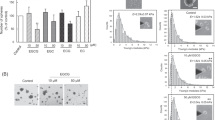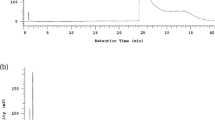Abstract
The hepatocyte growth factor (HGF) receptor, Met, is a strong prognostic indicator of breast cancer patient outcome and survival, suggesting that therapies targeting Met may have beneficial outcomes in the clinic. (−)-Epigallocatechin-3-gallate (EGCG), a catechin found in green tea, has been recognized as a potential therapeutic agent. We assessed the ability of EGCG to inhibit HGF signaling in the immortalized, nontumorigenic breast cell line, MCF10A, and the invasive breast carcinoma cell line, MDA-MB-231. HGF treatment in both cell lines induced rapid, sustained activation of Met, ERK and AKT. Pretreatment of cells with concentrations of EGCG as low as 0.3 μ M inhibited HGF-induced Met phosphorylation and downstream activation of AKT and ERK. Treatment with 5.0 μ M EGCG blocked the ability of HGF to induce cell motility and invasion. We assessed the ability of alternative green tea catechins to inhibit HGF-induced signaling and motility. (−)-Epicatechin-3-gallate (ECG) functioned similar to EGCG by completely blocking HGF-induced signaling as low as 0.6 μ M and motility at 5 μ M in MCF10A cells; whereas, (−)-epicatechin (EC) was unable to inhibit HGF-induced events at any concentration tested. (−)-Epigallocatechin (EGC), however, completely repressed HGF-induced AKT and ERK phosphorylation at concentrations of 10 and 20 μ M, but was incapable of blocking Met activation. Despite these observations, EGC did inhibit HGF-induced motility in MCF10A cells at 10 μ M. These observations suggest that the R1 galloyl and the R2 hydroxyl groups are important in mediating the green tea catechins' inhibitory effect towards HGF/Met signaling. These combined in vitro studies reveal the possible benefits of green tea polyphenols as cancer therapeutic agents to inhibit Met signaling and potentially block invasive cancer growth.
This is a preview of subscription content, access via your institution
Access options
Subscribe to this journal
Receive 50 print issues and online access
$259.00 per year
only $5.18 per issue
Buy this article
- Purchase on Springer Link
- Instant access to full article PDF
Prices may be subject to local taxes which are calculated during checkout









Similar content being viewed by others
Abbreviations
- EGCG:
-
(−)-epigallocatechin-3-gallate
- ECG:
-
(−)-epicatechin gallate
- EGC:
-
(−)-epigallocatechin
- EC:
-
(−)-epicatechin
- HGF:
-
hepatocyte growth factor
References
Adhami VM, Siddiqui IA, Ahmad N, Gupta S, Mukhtar H . (2004). Cancer Res 64: 8715–8722.
Berger SJ, Gupta S, Belfi CA, Gosky DM, Mukhtar H . (2001). Biochem Biophys Res Commun 288: 101–105.
Birchmeier C, Birchmeier W, Gherardi E, Vande Woude GF . (2003). Nat Rev Mol Cell Biol 4: 915–925.
Camp RL, Rimm EB, Rimm DL . (1999). Cancer 86: 2259–2265.
Cao Y, Cao R . (1999). Nature 398: 381.
Crespy V, Williamson G . (2004). J Nutr 134: 3431S–3440S.
Edakuni G, Sasatomi E, Satoh T, Tokunaga O, Miyazaki K . (2001). Pathol Int 51: 172–178.
Fang MZ, Wang Y, Ai N, Hou Z, Sun Y, Lu H et al. (2003). Cancer Res 63: 7563–7570.
Fujimura Y, Tachibana H, Yamada K . (2004). FEBS Lett 556: 204–210.
Ghoussoub RA, Dillon DA, D'Aquila T, Rimm EB, Fearon ER, Rimm DL . (1998). Cancer 82: 1513–1520.
Jung YD, Kim MS, Shin BA, Chay KO, Ahn BW, Liu W et al. (2001). Br J Cancer 84: 844–850.
Katiyar SK, Afaq F, Azizuddin K, Mukhtar H . (2001). Toxicol Appl Pharmacol 176: 110–117.
Kavanagh KT, Hafer LJ, Kim DW, Mann KK, Sherr DH, Rogers AE et al. (2001). J Cell Biochem 82: 387–398.
Lambert JD, Yang CS . (2003). J Nutr 133: 3262S–3267S.
Liang TJ, Reid AE, Xavier R, Cardiff RD, Wang TC . (1996). J Clin Invest 97: 2872–2877.
Liang YC, Lin-shiau SY, Chen CF, Lin JK . (1997). J Cell Biochem 67: 55–65.
Masuda M, Suzui M, Lim JT, Weinstein IB . (2003). Clin Cancer Res 9: 3486–3491.
Nakachi K, Suemasu K, Suga K, Takeo T, Imai K, Higashi Y . (1998). Jpn J Cancer Res 89: 254–261.
Nam S, Smith DM, Dou QP . (2001). J Biol Chem 276: 13322–13330.
Park M, Dean M, Cooper CS, Schmidt M, O'Brien SJ, Blair DG et al. (1986). Cell 45: 895–904.
Potempa S, Ridley AJ . (1998). Mol Biol Cell 9: 2185–2200.
Royal I, Park M . (1995). J Biol Chem 270: 27780–27787.
Sachinidis A, Seul C, Seewald S, Ahn H, Ko Y, Vetter H . (2000). FEBS Lett 471: 51–55.
Sah JF, Balasubramanian S, Eckert RL, Rorke EA . (2004). J Biol Chem 279: 12755–12762.
Su LJ, Arab L . (2002). Public Health Nutr 5: 419–425.
Sun CL, Yuan JM, Lee MJ, Yang CS, Gao YT, Ross RK et al. (2002). Carcinogenesis 23: 1497–1503.
Tachibana H, Koga K, Fujimura Y, Yamada K . (2004). Nat Struct Mol Biol 11: 380–381.
Tolgay Ocal I, Dolled-Filhart M, D'Aquila TG, Camp RL, Rimm DL . (2003). Cancer 97: 1841–1848.
Trusolino L, Comoglio PM . (2002). Nat Rev Cancer 2: 289–300.
Yang GY, Liao J, Kim K, Yurkow EJ, Yang CS . (1998). Carcinogenesis 19: 611–616.
Yang GY, Liao J, Li C, Chung J, Yurkow EJ, Ho CT et al. (2000). Carcinogenesis 21: 2035–2039.
Acknowledgements
This work was supported through Grant NIH R01 CA104242-01.
Author information
Authors and Affiliations
Corresponding author
Rights and permissions
About this article
Cite this article
Bigelow, R., Cardelli, J. The green tea catechins, (−)-Epigallocatechin-3-gallate (EGCG) and (−)-Epicatechin-3-gallate (ECG), inhibit HGF/Met signaling in immortalized and tumorigenic breast epithelial cells. Oncogene 25, 1922–1930 (2006). https://doi.org/10.1038/sj.onc.1209227
Received:
Revised:
Accepted:
Published:
Issue Date:
DOI: https://doi.org/10.1038/sj.onc.1209227
Keywords
This article is cited by
-
Influence of green tea consumption on endoxifen steady-state concentration in breast cancer patients treated with tamoxifen
Breast Cancer Research and Treatment (2020)
-
Aggregation of lipid rafts activates c-met and c-Src in non-small cell lung cancer cells
BMC Cancer (2018)
-
Stryphnodendron adstringens (“Barbatimão”) Leaf Fraction: Chemical Characterization, Antioxidant Activity, and Cytotoxicity Towards Human Breast Cancer Cell Lines
Applied Biochemistry and Biotechnology (2018)
-
Accumulation of catechins and expression of catechin synthetic genes in Camellia sinensis at different developmental stages
Botanical Studies (2016)
-
Quercetin inhibits HGF/c-Met signaling and HGF-stimulated melanoma cell migration and invasion
Molecular Cancer (2015)



